TAPAS.network | 6 June 2023 | Commentary | John Dales
STOLEN
Our Pavements. Let’s stop it!
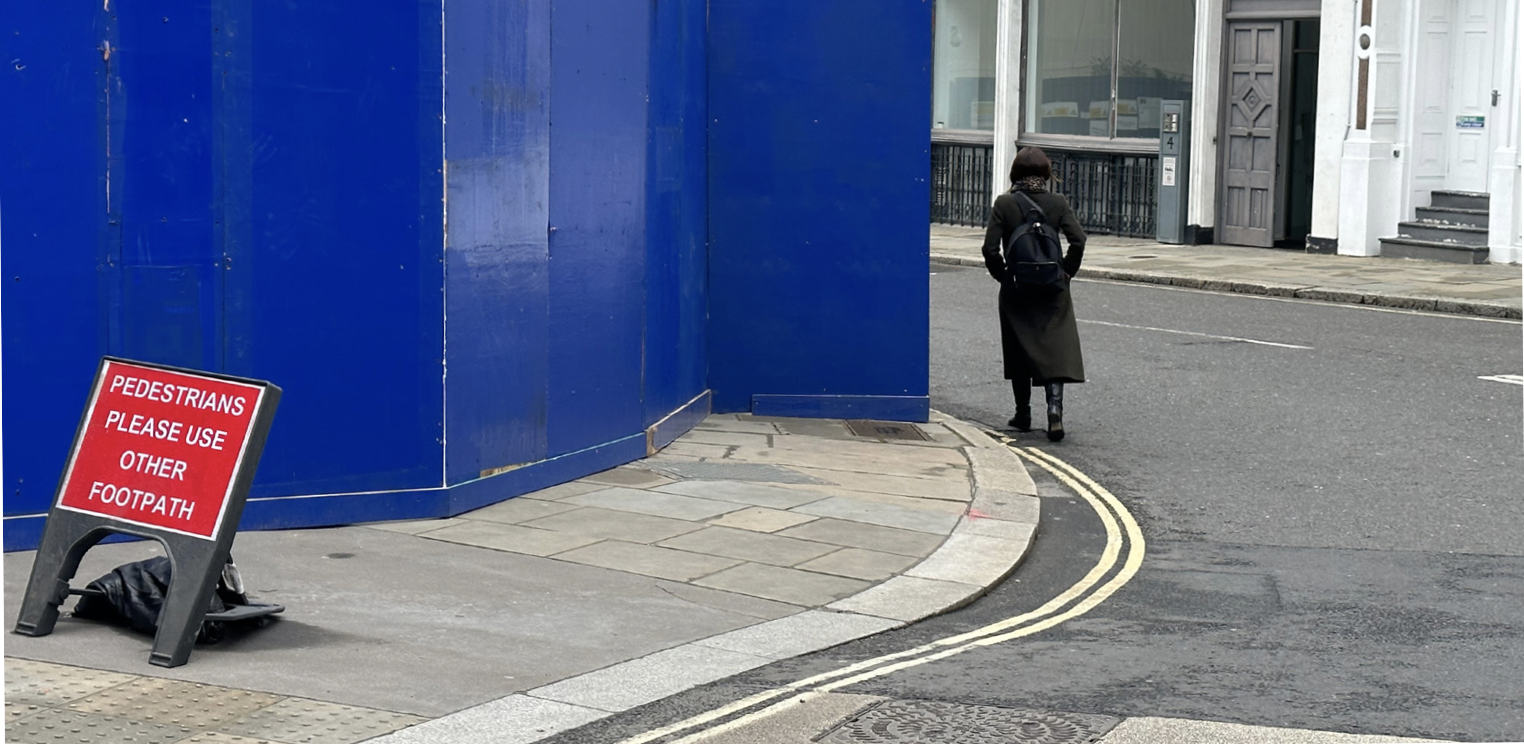

There’s an under-recognised crime wave of Footway Theft going on, believes . If walking is as important as we say it is, the footway is far more valuable than we treat it as, and we should stop the extensive stealing of it, he argues. It’s time to put our collective foot down on behalf of the intended users - pedestrians.
IN MY LAST PIECE, about the mistreatment of urban trees, you may possibly recall that I spoke of a theme I believe to be common both to the stories of the thoughtless tree destruction I reflected upon in Sheffield, Plymouth and around Euston station in London, (TAPAS, 24 April 2023) and to a seemingly unrelated matter that I promised to cover in my next TAPAS column. This is it, so that time has now come.
The theme in question comprises two threads: our general tolerance of actions that degrade the quality of our urban realm, and particularly streets; and the disconnect between those actions and the stated policies of those responsible for our built environment and transport priorities. The first relates to things that are so commonplace that they’ve become hidden in plain sight; normalised to the extent that we barely give them a thought. The second relates to Councils not doing as they say or, to put it another way, to avowed principles not actually being applied in practice.
The principle I want to focus on this time is the significance and deemed value of the area of public space ostensibly dedicated to the use of those moving around on foot, i.e. the footway (aka the pavement), at a time when the walking mode is now invariably placed at the top of what is now generally termed the sustainable transport hierarchy, an illustrated version of which is presented below.
Walking: top of the hierarchy, at least in theory
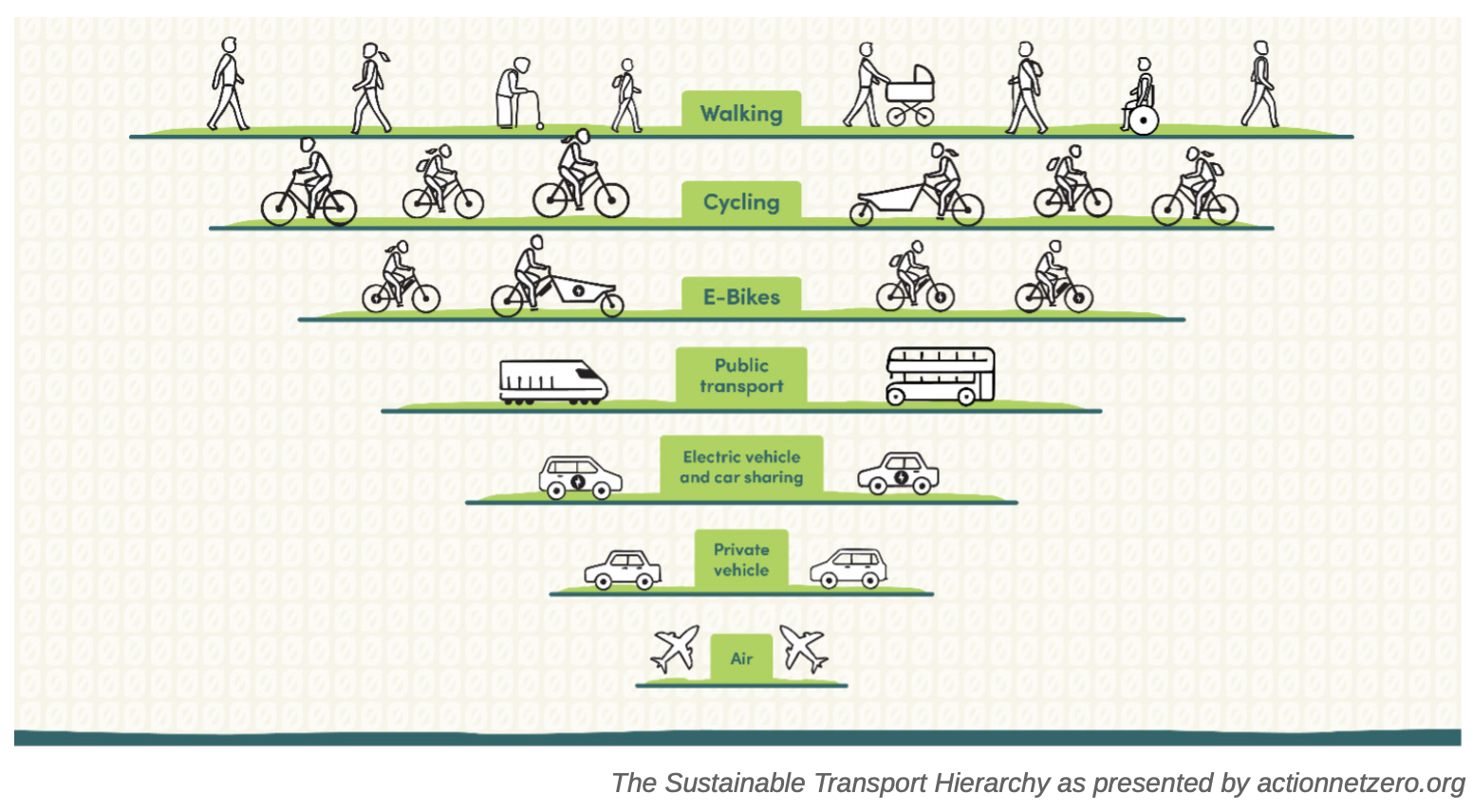
Many other versions of this type of diagram are available, but all of them have walking at the top. (The only exception I’ve seen is one that has digital communication in first place.) In other words, any local authority which has the sustainable transport hierarchy as a foundational element of its transport policy - and that’s now virtually every local authority in the land - is making the formal statement that walking is the most important mode of transport. It follows from this that walking should come first when considering the allocation and management of street space, and that all should be done to ensure conditions for walking – anywhere – should be as good as reasonably possible.
Perhaps I should just make clear that I don’t think that having walking at the top of the hierarchy means that the needs of people walking must be fully satisfied in every situation, or that those needs always take precedence over all other considerations. So, for example, I am personally content with the fact that you’re not allowed to walk along motorways. Similarly, I don’t believe that because footways on narrow streets in historic centres may be inadequately wide for the current footfall it should inevitably mean that all motor traffic should be banned so that the carriageway can be repurposed; or that the narrowness of the footways justifies the demolition of buildings so that widening can take place.
However, if the hierarchy means anything, it is surely that the quality of the walking environment shouldn’t be routinely diminished for the convenience, and financial benefit, of those to whom walking may seem of no present importance. The most obvious and frequent examples of this are the requirements of those who want to redevelop sites adjacent to the footway, or of those who otherwise need to temporarily occupy or close part of the footway to undertake other non-walking-related activities.
That the quality of the walking environment is indeed routinely diminished for such insufficient reasons will be evident to anyone who walks around UK towns and cities with any regularity, and is not blinded to the fact of such disturbance by it having become such a common sight. As it seemingly became with felled street trees, so it appears to be with footways partially or entirely hoarded off to accommodate the construction of buildings alongside, or to enable other works, such as in relation to statutory undertakers’ plant (power, water, telecoms, etc.) as I currently seem to see almost everywhere!
What I’ve come to think of as ‘the theft of the footway’ has been on my mind for quite a while, and was brought back to the forefront of my attention just recently when I was undertaking my annual long walk to work to celebrate the National Walking Month of May. This year, my walk took me 11½ miles from home to the office along part of the historic road between the City of London and Oxford, and I encountered numerous situations where the footway had been narrowed, or closed altogether, and yet wholly inadequate reprovision of equivalent safe space for walking had been made.
Now, ‘theft’ might seem the wrong term to use for a loss that is ‘only’ temporary. After all, those buildings will all be finished one day and the footway fully returned to the public; and those utility works will rarely last more than a few days. But the length of time that the footway is occupied for non-walking purposes isn’t the point. The fact that the footway has been taken at all, seemingly almost ‘on demand’ and without concern for the consequences, and hasn’t been properly replaced, is.
Disappearing footways: a sadly regular sight
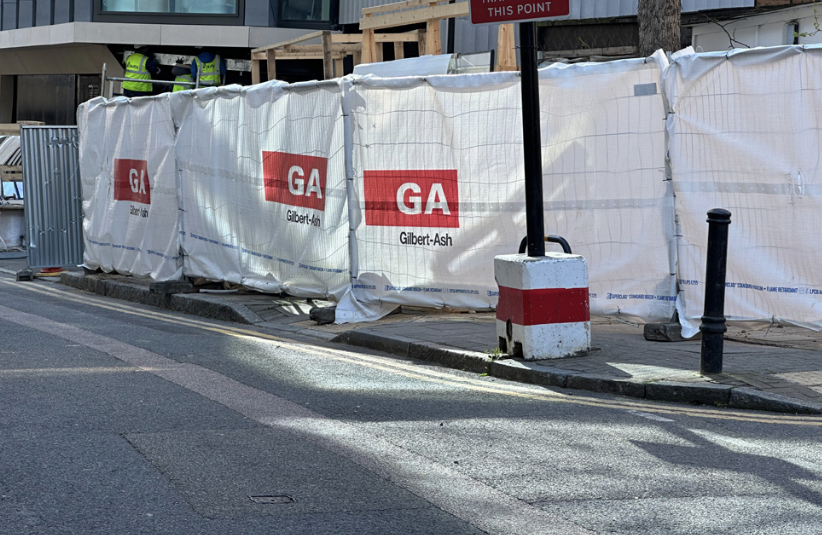
Not only has all the footway on one side of this street been taken for several months, the crossing point, which you’re still supposed to be able to get to, has been essentially blocked.
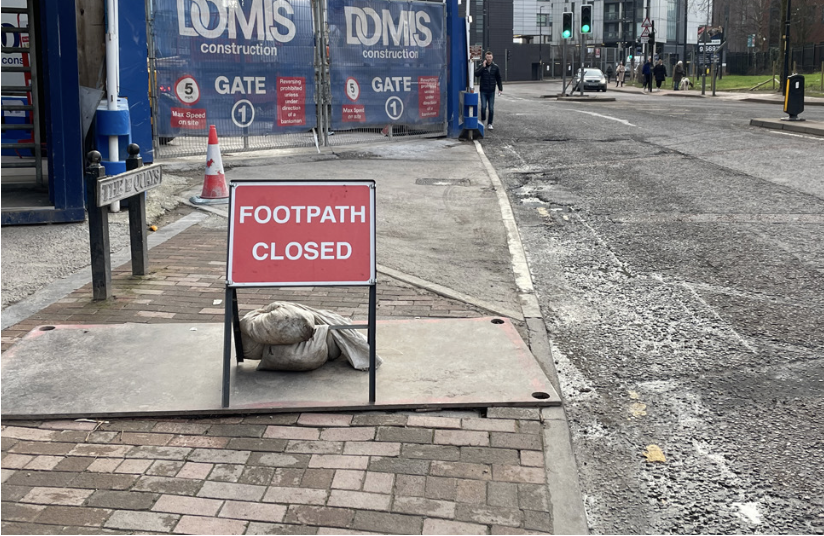
No assistance in crossing to the other side, just a sign saying the footway’s gone. As you can see from this photo, many people will still just walk in the footway. We know this will happen, but just turn a blind eye.
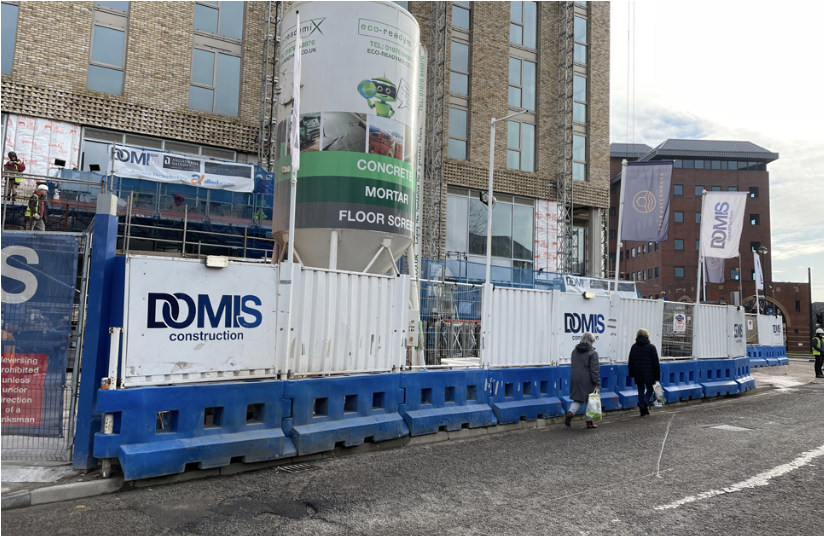
Whatever the notices say, many people will still choose to follow their desire line. A replacement footway in the carriageway is required in such circumstances.

To qualify as considerate, constructors should value people walking by, not just their workforce.
To be clear, the reason I’m writing about this is because although we say these days that walking is top of our transport priorities, we seem to carry on as if it’s bottom. Presumably no local authorities decide to assert the primacy of walking in their policies while hatching plans to undermine it in their actions. But they appear to let it happen anyway. So it’s clear that the placing of walking at the top of the transport tree is, far too often, a matter of good intention that fails to be carried through into the cut and thrust of everyday life.
“Walking is tops, obvs. However, that gas main does need replacing, so the footway does need to be dug up, and we can’t spare more than a metre of carriageway for a temporary walkway, or else the motor traffic (ostensibly bottom of the hierarchy) will, heaven forbid, get snarled up. And if a site is being redeveloped by some serious players who want to build right up to the back edge of the footway, does it seem a bit unreasonable to say they can’t just take over the public footway, under licence, to make their job (of making money for private investors) that bit easier?. In these circumstances, if those people really want to take the whole of that footway for a few months, and are willing to generously provide a ‘Footway Closed’ sign together with a pair of cheaply-installed ramps to help people cross to the footway on the other side, that’s surely good enough, isn’t it?”
It’s proverbially true that a picture paints a thousand words, so I’m going to leave the heavy lifting of this article to a clutch of photos that I’ve taken in recent months. Most of them illustrate the very problem I’m trying to describe, and most show some dreadful ‘solutions’. I hope that these will make you feel like Howard Beale, the character Peter Finch played in the 1976 film Network, when he urged his audience to shout: “I’m as mad as hell, and I’m not going to take this anymore!”
Stop. Look. Take notice. Realise it’s unacceptable. And demand better.
On my long walk the other day, I stopped at one of the sites where a good deal of the footway was now hidden behind hoardings to read the ‘Temporary Structure Licence’ notice that was affixed to those hoardings. This said that at least 1.2m of clear footway was to be maintained, a possibly reasonable-sounding minimum width, but one wholly inadequate for the busy part of London’s pedestrian-intensive West End, where the works were located. Just as importantly, I noticed that the licence has a start date of 10th November 2022 and an expiry date of 20th January 2023. I was reading the notice on 30th May.
Another walkway wiped out
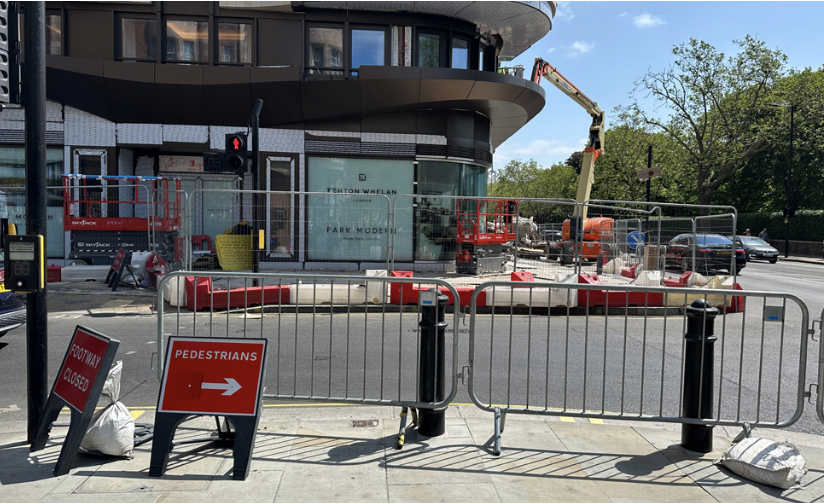
“That’s it. We’re taking your footway. All of it. But that’s OK, because there’s a sub-standard two-stage signalised crossing facility just to your right; and if you then walk for 100m you can cross back over at the next signals. Not that they have a pedestrian stage, mind.”
...but one kept alive
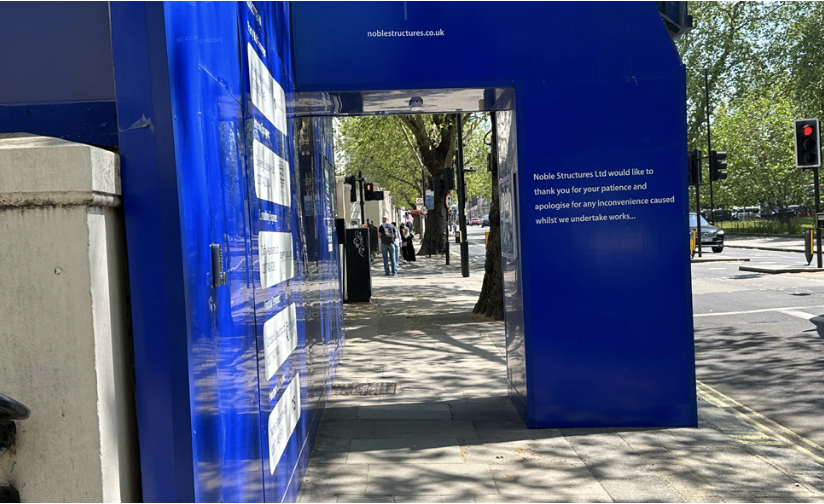
I’ve seen a lot worse. A small incursion into the footway on the left while, on the right, the structure is confined to the same zone that the large plane trees occupy. This is not an especially high footfall area.
To make myself clear, for the third time in this article, I’m not in the slightest suggesting that utilities shouldn’t be repaired, or that sites should never be re-developed. But I am saying that the footway shouldn’t be taken as expendable to enable such works, unless this is absolutely and unavoidably necessary, and certainly not without acceptable reprovision of footway space being made, and unless high quality crossing facilities are provided in situations where the footway is lost altogether.
I do wonder, in fact, whether the concept of a ‘Temporary Structure Licence’ is quite what is appropriate these days to deal with the full implications of extinguishing the right of way and provision of safe passage for those legitimately expecting to be able to walk along the footway in an urban area.
As to what might constitute ‘acceptable provision of footway space’, I think this should generally be like-for-like in terms of the pre-existing available clear pavement width for walking. If a reduction in walkway width is proposed, then the adequacy of this should be assessed using a tool such as the Pedestrian Comfort Guidance published by Transport for London in 2010. I have no time for arbitrary and general figures such as the 1.2m quoted above. If walking is important, we should be providing sufficient spaces for the numbers of walkers that pass each site in question, and we can easily establish what they actually are. This is a matter of counting footfall and calculating the walkway width required, not of plucking figures out of thin air, no matter how commonplace the use of such numbers might have been in the past.
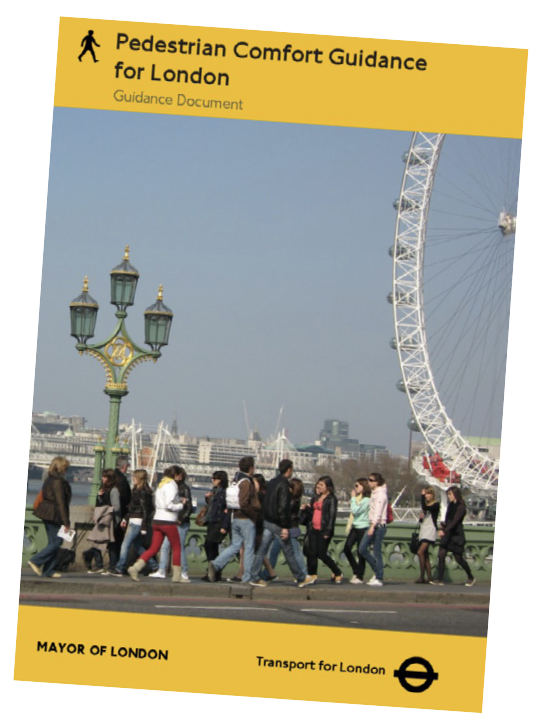
TfLs’ 2010 guidance is an excellent and well-researched tool for working out how much footway space is needed for a given volume of foot traffic. It should be more widely used.
It’s not that hard, is it? It’s mostly a matter of caring enough to do what we say, and showing that we care in what we do. I know we haven’t treated walking like it’s that important in the past, but we didn’t have our current transport policies or the sustainable transport hierarchy in the past either; nor did we previously value active travel, healthy lifestyles and achieving Net Zero as we do now. We can’t simply introduce all this new thinking, and feel virtuous for having done so, and yet carry on letting walking be squeezed out as a matter of course. We must either change how we act, or admit that we haven’t really moved forward if we don’t. And if we don’t, then we should be honest about it and change our transport policies and priorities back to how they were.
To make sure I am treading on firm ground, as it were, as I make my case on this I asked my friend the Ranty Highwayman, who knows more about many things than I do, what the process for obtaining one of those hoarding licences involves. He answered that licensees will usually be charged by the linear metre of the hoarding, and that the highway authority uses powers under section 172 of the Highways Act 1980 to manage the works. He added that the highway authority can also impose the requirement to provide alternative walkways, lighting, etc. and that they’ll usually ask for an insurance indemnity from the licensee. All this was borne out by the Temporary Structure Licence notice that I came across the other day.
Tunnel vision for pedestrians
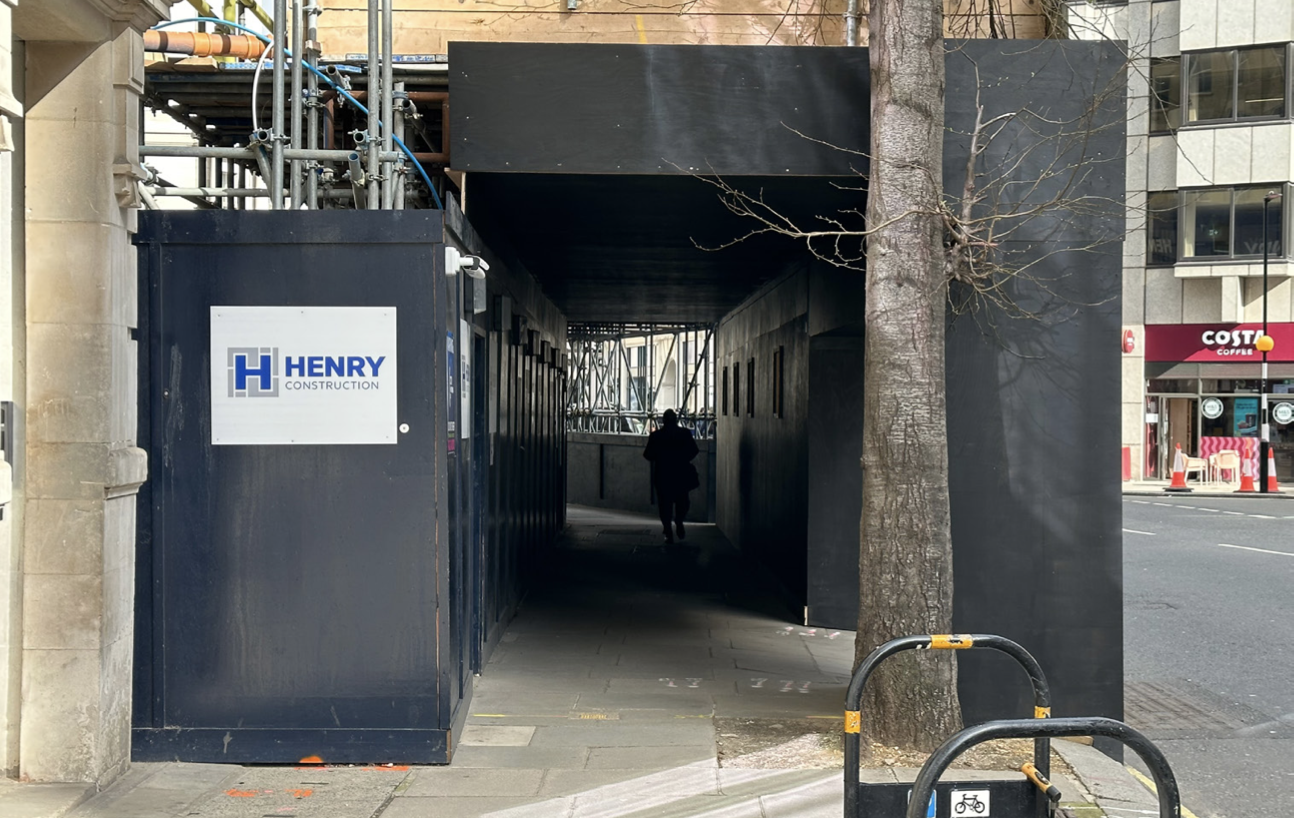
Compared with the example on the previous page, more footway is taken on the left, while the straddling structure on the right is again in the tree zone. The residual footway width might seem reasonable for the footfall in this location, but you can bet no formal assessment was made.
I then asked a follow-up question about how much the charge for taking out part of the footway might be, and Ranty answered that it’s pretty much up to each authority to set whatever charge it sees fit, although they’ll probably check each other out from time to time to benchmark their rates. He ended by saying that the main legal consideration is the recovery of reasonable costs, rather than making money. We could (and should) phrase that ‘making money’ issue differently though: for it’s not about revenue generation so much as it’s about compensating the community for the loss of benefit of use of the footway, and for bearing the burden of the consequential disturbance.
So, I think our mindset about accepting and/or dealing with the temporary loss of the footway should change. If walking is our no.1 mode of transport, and the footway is what enables that mode to function properly, then it follows that the footway is one of our most valuable public assets. If anyone wants to rent it out for use for alternative purposes for days, weeks or months on end, and thereby extinguish it’s proper use, then they should pay in accordance with that value and as a means of proving that walking is indeed as important as we say it is.
As I mentioned in some of my TAPAS pieces last year (specifically TAPAS 5 September 2022, but also TAPAS 17 October 2022 and TAPAS 19 December 2022), the public highway generally is an extremely valuable public asset that we routinely under value, and often just give away. When it comes to the footway, which is the most valuable part of that valuable asset, if our transport hierarchy is to be believed, the importance of protecting it and seeking appropriate compensation when it’s used for other purposes is surely all the greater. Maybe, it’s by putting a proper monetary value on footway space that local authorities can finally accustom themselves to adopting the practice that should necessarily flow from their pro-walking policy. And if authorities finally doing what they say on walking has consequences for other road users or neighbouring property interests, and it will, then so be it. Let’s recognise that reality and properly address it, not continue with the current approach of fudging the issue.
John Dales is a streets design adviser to local authorities around the UK, a member of several design review panels, and one of the London Mayor’s Design Advocates. He’s a past chair of the Transport Planning Society, a former trustee of Living Streets, and a committee member of the Parliamentary Advisory Council for Transport Safety. He is director of transport planning and street design consultancy Urban Movement.
This article was first published in LTT magazine, LTT870, 6 June 2023.
You are currently viewing this page as TAPAS Taster user.
To read and make comments on this article you need to register for free as TAPAS Select user and log in.

Log in